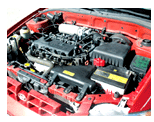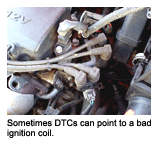As import car techs, we can’t ignore Korean-made cars: They’re making the same inroads into the market that the Japanese cars did in the late ‘70s and early ‘80s. By providing good value, quality cars and strong warranties, there’s no reason to think they won’t enjoy the same success.
Let’s take a look at some problems you may face with Hyundai’s line of cars, with an eye toward driveability and check engine problems. But, first, this point is worth repeating: Check the basics. Any honest tech has a story of hours wasted on a diagnosis that turned out to be an overlooked mechanical or simple condition that should have been eliminated early in the process. I believe the increase in technology has made this a bigger issue, as we spend more time chasing and relying more heavily on codes to diagnose driveability complaints.
 DRIVEABILITY ISSUES
DRIVEABILITY ISSUES
It’s important to remember that codes are circuit- or system-specific, and not sensor- or part-specific. While codes are a big help in sending you in the right direction and will sometimes pinpoint a faulty part, it’s a gambling tech who doesn’t first confirm the sensor is bad and the circuit is intact.
Years ago, we had an early ‘90s Excel with crimp problems in the ground side of the harness that gave us fits with intermittent problems that seemed to change sensors from road test to road test. With the cooling temp sensor, air flow meter and intake air temp sensor all sharing the same ground circuit, the codes would move from system to system. We got the car with all sensors freshly installed, but it had the same recurring driveability, starting and code issues. Being a pre-OBD II car, we didn’t have the benefit of freeze-frame data or more detailed codes that would have been a big help in this instance. By using the freeze-frame function, we would have known the computer was seeing the circuit or sensor go open. Instead we were forced to visually observe voltage readings, finally catching the ground side going open on a road test. On this particular job, we repaired it by adding grounds at the sensors. While not very common, harnesses and connectors have been a problem with Hyundais and should always be considered; don’t overlook the ground connections. If in doubt, clean, tighten and repair them.
Thankfully, diagnostic strategies, capabilities and equipment have improved dramatically for all cars, since the advent of OBD II. These are major steps forward, but we always have to keep the basics in mind. While the technology will tell us which cylinder is misfiring or to what extreme the fuel trim is reaching, we need to determine why. Even when using a scanner, think about checking the basics using the data list. It takes only a few minutes to look at the data and get an idea where you are: Things like temp, 02, air mass and throttle sensor inputs can tell you pretty quickly what the ECU is seeing, while fuel trims will show how much fuel correction is taking place and how well it’s being done. That’s a lot of good information for little effort.
If a code is set, be sure to take a look at that data and don’t overlook the freeze-frame function, especially if it’s unfamiliar. It’s been my experience that Hyundais communicate well and, depending on your software, share a great deal of information.
CODE BREAKING
The most common code we see is the P0300 series of misfire codes. All automakers have gone to coil packs or coil-on-plug systems on their vehicles to better control misfire. I’m sure we’re all familiar with these systems, but it can’t hurt to remind ourselves and our techs what to watch for that will prevent problems in the future and help diagnose a misfire code.
Whenever the coils or wires are removed to service the plugs, take the time to clean and inspect the plug boots and do a good visual inspection with an eye toward spark leakage. The same tactic will be necessary and valuable as you diagnose misfire codes. While you can look at the secondary ignition with KV modules and low-amp probes, spark leakage to the plug tube will do a good job of mimicking a spark gap, possibly sending you in the wrong direction.
Don’t overlook checking the condition of the spark plugs; these cars run so well it’s easy for the customer to overlook some recommended service. This is a good opportunity to point out that better maintenance practices pay dividends and may have avoided this problem. At the very least, we want to be sure that our new ignition parts aren’t being over-taxed by worn-out spark plugs. And as I mentioned earlier, don’t forget the basics; while those plugs are out, it takes only a couple of minutes to take compression — why not check it?
On the Accent we were diagnosing, we had P0300, P0301 and P0303 codes indicating random as well as cylinder one and three misfires, along with a P1128 system lean code. In these instances, I go after the misfire codes first since the lean code could be a result of the misfires and high oxygen content in the exhaust. In this case, we repaired the misses with wires and plugs, and monitored long-term trim to confirm the parameters weren’t exceeded.
After misfire codes, the lean code is another frequent issue we see, often with no driveability complaint. While some folks refer to this as an oxygen sensor code, I would warn against jumping to conclusions. If the sensor seems to operate well but is biased lean, it’s a good indication that the engine is indeed lean and the sensor is doing its job by reporting that information.
Again, it’s back to the basics, looking for vacuum leaks or unmetered air entering the engine. There have been plenty of reports of dirty mass air flow sensors causing this code. It can be tough to confirm a bad sensor, but if you have a labscope this is a good place to use it: Look for voltage dropouts and output during snap throttle tests. Be sure to check for TSBs as Hyundai has come out with expected numbers that can be monitored on most scan tools.
Armed with freeze-frame data and good service information, you should be able to recommend a new sensor with confidence. Some techs report good success with careful cleaning of the mass air flow sensor. I can’t say I’ve had that experience, and would recommend cleaning only as a diagnostic step. If cleaning makes it better, install a new unit and be sure all the incoming air is filtered through a high-quality part.
INFORMATION AGE
When it comes to Hyundais, there’s no reason not to have all the information you need via free access to the Hyundai website (www.hmaservice.com). As an example, I’ve included the failure conditions for the P1128 code we had on the Accent. We can see that code sets when rpm is under 1,000 (idle) and more than 15% of fuel is being added, making it easy to confirm the repair by looking at LTT at idle.
This is a prime example of the time saved on a tough problem that’s already been identified and taken care of with a TSB or re-flash. I know I would have saved a lot of time with that bad harness splice on that Excel if I had the wiring diagrams and harness information this site gives us.
 FAILURE CONDITIONS
FAILURE CONDITIONS
(From the Hyundai website)
For Short-Term Fuel Trim
The ECM will set a code and the Malfunction Indicator Lamp (MIL) will turn on if the short-term fuel trim value goes 10% to 15% rich [for P1123], or if the short-term fuel trim additive value is less than 0.4 milliseconds, or 10% to 15% lean [for P1124] for 30 seconds during two driving cycles when the following conditions are met:
ECM is in closed-loop operation.
Engine speed is below 1,000 rpm.
Engine coolant temperature is above 158° F (70° C).
Canister purge system is not operating.
Mass air flow is less than 7.5 g/s [for P1123] or 5.5 g/s [for P1124].
For Long-Term Fuel Trim
The ECM will set a code and the Malfunction Indicator Lamp (MIL) will turn on if the long-term multiplicative value is less than 77% for 30 seconds [for P1127] or if the long-term fuel trim value goes to 10% to 15% lean [for P1128] for 30 seconds during two driving cycles when the following conditions are met:
Engine load exceeds 1.8 milliseconds.
ECM is in closed-loop operation [for P1127].
Engine coolant temperature is above 158° F (70° C).
Canister purge system is not operating.
Mass air flow is less than 7.5 g/s or 5.5 g/s.
Engine speed is below 1,000 rpm [for P1128].
OTHER PROBLEMS
Some other things that could be challenging on Hyundais include purge valves that stick in the open position, resulting in hard starts and stalling after refueling. The problem clears up once the “flooded” condition is cleared out, but could have you scratching your head if you’re not aware of it.
The Sonata 2.4s have tricked a couple of guys with crank sensor problems after timing and balance belts have been replaced. Be careful to remove all of the damaged belt and loose teeth from the crank sensor area. Both the sensor and trigger wheel are suspect to damage and should always be checked; often the balance belt will break and the only indication to the customer is when the pieces take out the sensor. It’s also easy to install the sensor “backward” that will naturally result in a no-start; be sure the sensor is seeing the trigger, and the wire is routed properly before the cover goes back on.
Last, but certainly not least, are the problems you can have setting OBD monitors on these cars. This is a pressing problem as many states are going with an annual OBD emission compliance test that mandates monitors be set. Look at the Hyundai website — there’s a generic drive cycle listed for all but the newest models.
But digging deeper, we find a TSB for many models, including the Accent, with a more detailed procedure and enabling criteria. Of note on the cars built in the late ‘90s, is that fact that all of two trip monitors have to run both trips for any of the monitors to set, certainly increasing the challenge and making the information contained in the TSB that much more valuable. When looking at later-year Accents, a re-flash is listed for the EVAP monitor that may report a false “incomplete,” further reinforcing how important it is we have good service information.












